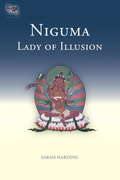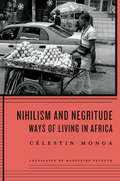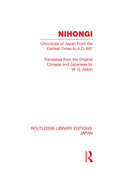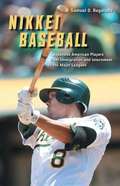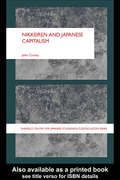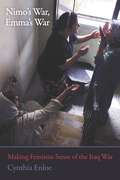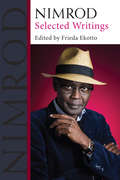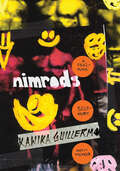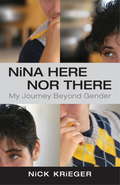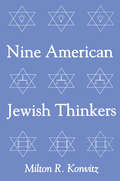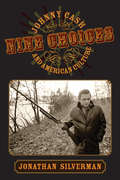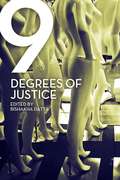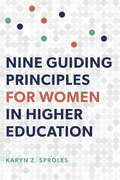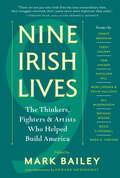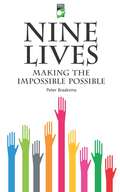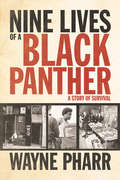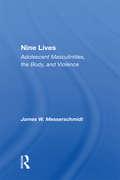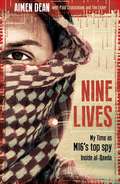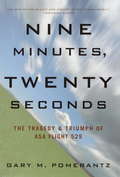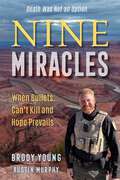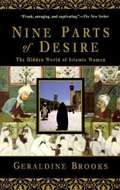- Table View
- List View
Nightwork: Sexuality, Pleasure, and Corporate Masculinity in a Tokyo Hostess Club
by Anne AllisonIn Nightwork, Anne Allison opens a window onto Japanese corporate culture and gender identities. Allison performed the ritualized tasks of a hostess in one of Tokyo's many "hostess clubs": pouring drinks, lighting cigarettes, and making flattering or titillating conversation with the businessmen who came there on company expense accounts. Her book critically examines how such establishments create bonds among white-collar men and forge a masculine identity that suits the needs of their corporations. Allison describes in detail a typical company outing to such a club—what the men do, how they interact with the hostesses, the role the hostess is expected to play, and the extent to which all of this involves "play" rather than "work. " Unlike previous books on Japanese nightlife, Allison's ethnography of one specific hostess club (here referred to as Bijo) views the general phenomenon from the eyes of a woman, hostess, and feminist anthropologist. Observing that clubs like Bijo further a kind of masculinity dependent on the gestures and labors of women, Allison seeks to uncover connections between such behavior and other social, economic, sexual, and gendered relations. She argues that Japanese corporate nightlife enables and institutionalizes a particular form of ritualized male dominance: in paying for this entertainment, Japanese corporations not only give their male workers a self-image as phallic man, but also develop relationships to work that are unconditional and unbreakable. This is a book that will appeal to anyone interested in gender roles or in contemporary Japanese society.
Nightwork: Sexuality, Pleasure, and Corporate Masculinity in a Tokyo Hostess Club
by Anne AllisonIn Nightwork, Anne Allison opens a window onto Japanese corporate culture and gender identities. Allison performed the ritualized tasks of a hostess in one of Tokyo's many "hostess clubs": pouring drinks, lighting cigarettes, and making flattering or titillating conversation with the businessmen who came there on company expense accounts. Her book critically examines how such establishments create bonds among white-collar men and forge a masculine identity that suits the needs of their corporations. Allison describes in detail a typical company outing to such a club—what the men do, how they interact with the hostesses, the role the hostess is expected to play, and the extent to which all of this involves "play" rather than "work." Unlike previous books on Japanese nightlife, Allison's ethnography of one specific hostess club (here referred to as Bijo) views the general phenomenon from the eyes of a woman, hostess, and feminist anthropologist. Observing that clubs like Bijo further a kind of masculinity dependent on the gestures and labors of women, Allison seeks to uncover connections between such behavior and other social, economic, sexual, and gendered relations. She argues that Japanese corporate nightlife enables and institutionalizes a particular form of ritualized male dominance: in paying for this entertainment, Japanese corporations not only give their male workers a self-image as phallic man, but also develop relationships to work that are unconditional and unbreakable. This is a book that will appeal to anyone interested in gender roles or in contemporary Japanese society.
Niguma, Lady of Illusion
by Sarah Harding"Providing a rare glimpse of feminine Buddhist history, Niguma, Lady of Illusion brings to the forefront the life and teachings of a mysterious eleventh-century Kashmiri woman who became the source of a major Tibetan Buddhist practice lineage. The circumstances of her life and extraordinary qualities ascribed to her are analyzed in the greater context of spiritual biography and Buddhist doctrine. More than a historical presentation, Niguma's story raises the question of women as real spiritual leaders versus male images of feminine principle and other related contemporary issues. This volume includes the thirteen works that have been attributed to Niguma in the Tibetan Buddhist canon. These collected works form the basis of an ancient lineage Shangpa, which continues to be actively studied and practiced today. These works include the source verses for such esoteric practices as the Six Yogas, the Great Seal, and the Chakrasamvara and Hevajra tantric practices that are widespread in Tibetan traditions. Also included is the only extant biography, which is enhanced by the few other sources of information on her life and work. "
Nihilism and Negritude
by Célestin MongaIn a searching meditation on ways of living in modern Africa, Célestin Monga dispels the stereotypes that cloud how outsiders view the continent, and how Africans sometimes view themselves. He shows how dance, music, bodily experience, faith, and mourning reflect a nihilism that finds meaning and joy in a life that would otherwise seem absurd.
Nihilism and Negritude: Ways of Living in Africa
by Célestin MongaThere are two common ways of writing about Africa, says Célestin Monga. One way blames Africa’s ills on the continent’s history of exploitation and oppression. The other way blames Africans themselves for failing to rise above poisonous national prejudices and resentments. But patronizing caricatures that reduce Africans to either victims or slackers do not get us very far in understanding the complexities and paradoxes of Africa today.A searching, often searing, meditation on ways of living in modern Africa, Nihilism and Negritude dispels the stereotypes that cloud how outsiders view the continent—and how Africans sometimes view themselves. In the role of a traveler-philosopher, Monga seeks to register “the picturesque absurdity of daily life” in his native Cameroon and across the continent. Whether navigating the chaotic choreography of street traffic or discoursing on the philosophy of café menus, he illuminates the patterns of reasoning behind everyday behaviors and offers new interpretations of what some observers have misunderstood as Africans’ resigned acceptance of suffering and violence.Monga does not wish to revive Negritude, the once-influential movement that sought to identify and celebrate allegedly unique African values. Rather, he seeks to show how daily life and thought—witnessed in dance and music, sensual pleasure and bodily experience, faith and mourning—reflect a form of nihilism developed to cope with chaos, poverty, and oppression. This is not the nihilism of despair, Monga insists, but the determination to find meaning and even joy in a life that would otherwise seem absurd.
Nihongi: Chronicles of Japan From the Earliest Times to A D 697 (Routledge Library Editions: Japan)
by W. G. AstonThe Nihongi is the standard native history of Ancient Japan. This volume, originally published in 1896 and now of classic status makes accessible to European scholars the extensive store of material for the study of mythology, folk-lore, early civilization and manners and customs which it contains.
Nikkei Baseball: Japanese American Players from Immigration and Internment to the Major Leagues
by Samuel O. RegaladoNikkei Baseball examines baseball's evolving importance to the Japanese American community and the construction of Japanese American identity. Originally introduced in Japan in the late 1800s, baseball was played in the United States by Japanese immigrants first in Hawaii, then San Francisco and northern California, then in amateur leagues up and down the Pacific Coast. For Japanese American players, baseball was seen as a sport that encouraged healthy competition by imposing rules and standards of ethical behavior for both players and fans. The value of baseball as exercise and amusement quickly expanded into something even more important, a means for strengthening social ties within Japanese American communities and for linking their aspirations to America's pastimes and America's promise. With World War II came internment and baseball and softball played behind barbed wire. After their release from the camps, Japanese Americans found their reentry to American society beset by anti-Japanese laws, policies, and vigilante violence, but they rebuilt their leagues and played in schools and colleges. Drawing from archival research, prior scholarship, and personal interviews, Samuel O. Regalado explores key historical factors such as Meji-era modernization policies in Japan, American anti-Asian sentiments, internment during World War II, the postwar transition, economic and educational opportunities in the 1960s, the developing concept of a distinct "Asian American" identity, and Japanese Americans' rise to the major leagues with star players including Lenn Sakata and Kurt Suzuki and even managers such as the Seattle Mariners' Don Wakamatsu.
Nikkeiren and Japanese Capitalism (The University of Sheffield/Routledge Japanese Studies Series)
by John CrumpThis book provides a history of Nikkeiren (the Japanese Federation of Managers' Organisations) and an account of post-war capitalist development in Japan. The author challenges the principal interpretations of how the economy functions revealing a darker side of Japanese capitalism in his examination of the roles played by class power, manipulation and mystification.
Nimo's War, Emma's War: Making Feminist Sense of the Iraq War
by Cynthia EnloeIn a book that once again blends her distinctive flair for capturing the texture of everyday life with shrewd political insights, Cynthia Enloe looks closely at the lives of eight ordinary women, four Iraqis and four Americans, during the Iraq War.
Nimo's War, Emma's War: Making Feminist Sense of the Iraq War
by Cynthia EnloeNimo, Maha, Safah, Shatha, Emma, Danielle, Kim, Charlene. In a book that once again blends her distinctive flair for capturing the texture of everyday life with shrewd political insights, Cynthia Enloe looks closely at the lives of eight ordinary women, four Iraqis and four Americans, during the Iraq War. Among others, Enloe profiles a Baghdad beauty parlor owner, a teenage girl who survived a massacre, an elected member of Parliament, the young wife of an Army sergeant, and an African American woman soldier. Each chapter begins with a close-up look at one woman’s experiences and widens into a dazzling examination of the larger canvas of war’s gendered dimensions. Bringing to light hidden and unexpected theaters of operation—prostitution, sexual assault, marriage, ethnic politics, sexist economies—these stories are a brilliant entryway into an eye-opening exploration of the actual causes, costs, and long-range consequences of war. This unique comparison of American and Iraqi women’s diverse and complex experiences sheds a powerful light on the different realities that together we call, perhaps too easily, "the Iraq war."
Nimrod: Selected Writings (African Perspectives)
by Frieda EkottoThe Chadian writer Nimrod—philosopher, poet, novelist, and essayist—is one of the most dynamic and vital voices in contemporary African literature and thought. Yet little of Nimrod’s writing has been translated into English until now. Introductory material by Frieda Ekotto provides context for Nimrod’s work and demonstrates the urgency of making it available beyond Francophone Africa to a broader global audience. At the heart of this volume are Nimrod’s essays on Léopold Sédar Senghor, a key figure in the literary and aesthetic Négritude movement of the 1930s and president of Senegal from 1945 through 1980. Widely dismissed in recent decades as problematically essentialist, Senghorian Negritude articulated notions of “blackness” as a way of transcending deep divisions across a Black Diaspora under French colonial rule. Nimrod offers a nuanced reading of Senghor, drawing out the full complexities of Senghor’s philosophy and reevaluating how race and colonialism function in a French-speaking space. Also included in this volume are Nimrod’s essays on literature from the 2008 collection, The New French Matter (La nouvelle chose française). Representing his prose fiction is his 2010 work, Rivers’ Gold (L’or des rivières). Also featured are some of Nimrod’s best-loved poems, in both English translation and the original French. The works selected and translated for this volume showcase Nimrod’s versatility, his intellectual liveliness, and his exploration of questions of aesthetics in African literature, philosophy, and linguistics. Nimrod: Selected Writings marks a significant contribution toward engaging a broader audience with one of the vital voices of our time. This book will be essential reading for Anglophone students and scholars of African philosophy, literature, poetry, and critical theory, and will offer a welcome introduction to Nimrod for general readers of contemporary international writing.
Nimrods: a fake-punk self-hurt anti-memoir
by Kawika GuillermoIn Nimrods, Kawika Guillermo chronicles the agonizing absurdities of being a newly minted professor (and overtired father) hired to teach in a Social Justice Institute while haunted by the inner ghosts of patriarchy, racial pessimism, and imperial arrogance. Charged with the “personal is political” mandate of feminist critique, Guillermo honestly and powerfully recounts his wayward path, from being raised by two preachers’ kids in a chaotic mixed-race family to his uncle’s death from HIV-related illness, which helped prompt his parents' divorce and his mother’s move to Las Vegas, to his many attempts to flee from American gender, racial, and religious norms by immigrating to South Korea, China, Hong Kong, and Canada. Through an often crass, cringey, and raw hybrid prose-poetic style, Guillermo reflects on anger, alcoholism, and suicidal ideation—traits that do not simply vanish after one is cast into the treacherous role of fatherhood or the dreaded role of professor. Guillermo’s shameless mixtures of autotheory, queer punk poetry, musical ekphrasis, haibun, academic (mis)quotations, and bad dad jokes present a bold new take on the autobiography: the fake-punk self-hurt anti-memoir.
Nina Here nor There: My Journey Beyond Gender
by Nick KriegerThe next-generation Stone Butch Blues--a contemporary memoir of gender awakening and a classic tale of first love and self-discovery. Ambitious, sporty, feminine "capital-L lesbians" had been Nina Krieger's type, for friends that is. She hadn't dated in seven years, a period of non-stop traveling--searching for what, or avoiding what, she didn't know. When she lands in San Francisco's Castro neighborhood, her roommates introduce her to a whole new world, full of people who identify as queer, who modify their bodies and blur the line between woman and man, who defy everything Nina thought she knew about gender and identity. Despite herself, Nina is drawn to the people she once considered freaks, and before long, she is forging a path that is neither man nor woman, here nor there. This candid and humorous memoir of gender awakening brings readers into the world of the next generation of transgender warriors and tells a classic tale of first love and self-discovery.
Nine American Jewish Thinkers
by Milton KonvitzThe nine American Jews of whom Milton Konvitz writes are philosophers, jurists, or rabbis, widely known and readily accepted as American Jewish thinkers. Their work reflects all essential Jewish values. Each person in his own way has dedicated his work to the betterment of life and the advancement of human ideals. In this sense, their Jewishness is not defined by religion alone. Americanism permeated all they thought and all they did.Konvitz argues that in the complex modern world, secularists often serve God more handsomely than do members of synagogues or churches. For example, when the Supreme Court in 1954 (with Felix Frankfurter playing a key role behind the scenes) agreed to outlaw segregation of the races in public schools, was the Court's action secular or religious? When Congress passed the statute known as the Americans with Disabilities Act, requiring equal treatment of handicapped persons, was the action secular or religious? Is a minimum wage act secular or religious? Is Medicaid a secular or a religious act? Konvitz believes the distinction is not useful, or even possible.The book is divided into three parts, reflecting Konvitz's range of intellectual interests. The nine essays offer concise intellectual biographies of three American Jewish philosophers, three Supreme Court Justices, and three rabbis. The philosophers-Horace M. Kallen, Morris Raphael Cohen, and Sidney Hook-are world-renowned. The jurists-Louis D. Brandeis, Benjamin N. Cardozo, and Felix Frankfurter-hold prominent places in American legal history. And the three rabbis-Leo Jung, Robert Gordis, and Jacob Agus-are known wherever Jewish thought is studied. By treating with equal seriousness the lives and writings of both religious and secularist thinkers, the author intentionally minimizes the conventional antagonism and frequent conflict between religion and secularism.An unusual feature of the book is the fact that the author was a close friend of six of the persons whose lives and work are examined, allowing him a perceptive insight into their character and thought. Although the book is about serious subjects, its graceful style makes the contents easily accessible to lay persons as well as scholars and students of Judaica.
Nine Choices: Johnny Cash and American Culture
by Jonathan SilvermanFor much of his career, Johnny Cash opened his shows with the tagline, "Hello, I'm Johnny Cash." This introduction seemed unnecessary, since everyone in the audience knew who he was--the famous musical artist whose career spanned almost five decades, whose troubled life on and off the stage received wide publicity, and whose cragged face seemed to express a depth and intensity not found in any other artist, living or dead. For Cash, as for many celebrities, renown was the product of both hard work and luck. Often a visionary and always a tireless performer, he was subject to a whirlwind of social, economic, and cultural countercurrents. Nine Choices explores the tension between Cash's desire for mainstream success, his personal struggles with alcohol and drugs, and an ever-changing cultural landscape that often circumscribed his options. Drawing on interviews, archival research, and textual analysis, Jonathan Silverman focuses on Cash's personal and artistic choices as a way of understanding his life, his impact on American culture, and the ways in which that culture in turn shaped him. Cash made decisions about where he would live, what he would play, who would produce his albums, whether he would support the Vietnam War, and even if he would flip his famous "bird"--the iconic image of Cash giving the finger which is now plastered on posters and T-shirts everywhere--in the context of cultural forces both visible and opaque. He made other decisions in consultation with a variety of people, many of whom were chiefly concerned with the reaction of his audiences. Less a conventional biography than a study of the making of an identity, Nine Choices explores how Johnny Cash sought to define who he was, how he was perceived, and what he signified through a series of self-conscious actions. The result, Silverman shows, was a life that was often tumultuous but never uninteresting.
Nine Degrees of Justice
by Bishakha DattaFrom an early focus on rape, dowry and sati, feminist struggles against violence on women in India have traversed a wide terrain to include issues that were invisible in the1980s. In Nine Degrees of Justice, second- and third-generation feminists share their perceptions on violence against women through a series of thought-provoking essays that establish that justice for women has not even reached double digit figures (hence nine degrees). Has using the law led to justice for women who face violence? What does 'justice' mean for an individual survivor? How can we address violence in public spaces and cyberspace without demonizing either? How do women in armed conflict move from being victims to actors? How can we start to speak about lesbian suicides and violence among women loving women? How do we ensure that women have a 'right to choose' when love is seen as a crime? Is prostitution a form of violence against women? What is the violence of stigma? And who is a 'woman' deserving representation from the women's movement?
Nine Guiding Principles for Women in Higher Education
by Karyn Z. SprolesHighlighting the nine guiding principles to help women succeed in their academic careers.Although there are more women in higher education than ever before—and increasingly in leadership positions—their paths to success are more difficult than those paved for men. Nine Guiding Principles for Women in Higher Education is a concise and accessible resource aimed at helping women faculty succeed in their academic careers. Karyn Z. Sproles offers guidance, humor, and courage to women in higher education, paying particular attention to those with children and women of color. Based on a wide range of scholarship, stories from dozens of women, and Sproles's personal experience from 34 years as a professor, department chair, and dean, Nine Principles offers advice on• facing down impostor syndrome,• avoiding social isolation,• building networks of mentors,• preparing for tenure,• balancing teaching, scholarship, and home life,and more.Practical and visionary, the nine principles guide readers from the beginning of their careers through to leadership roles. Women in academia—including adjuncts, graduate students, and tenure-track professors—will find the tools they need to balance success with the rest of life's demands. Each chapter ends with a quick list of advice for easy reference and suggested reading to explore more on the chapter's topic. Rounding out the book is a workshop section that can be used by individual readers or as a guide for conducting workshops and faculty development programs.
Nine Irish Lives: The Thinkers, Fighters, and Artists Who Helped Build America
by Mark Bailey“These are not just nine Irish lives but nine extraordinary lives, their struggles universal, their causes never more important than today. As the saying goes, the best stories belong to those who can tell them. And these are well told, by some of our best storytellers.” —Timothy Egan, New York Times bestselling author of The Immortal Irishman In this entertaining and timely anthology, nine contemporary Irish Americans present the stories of nine inspiring Irish immigrants whose compassion, creativity, and indefatigable spirit helped shape America. The authors here bring to bear their own life experiences as they reflect on their subjects, in each essay telling a unique and surprisingly intimate story. Rosie O’Donnell, an adoptive mother of five, writes about Margaret Haughery, the Mother of Orphans. Poet Jill McDonough recounts the story of a particularly brave Civil War soldier, and filmmaker and activist Michael Moore presents the original muckraking journalist, Samuel McClure. Novelist Kathleen Hill reflects on famed New Yorker writer Maeve Brennan, and historian Terry Golway examines the life of pivotal labor leader Mother Jones. In his final written work, activist and politician Tom Hayden explores his own namesake, Thomas Addis Emmet. Nonprofit executive Mark Shriver writes about the priest who founded Boys Town, and celebrated actor Pierce Brosnan—himself a painter in his spare time—writes about silent film director Rex Ingram, also a sculptor. And a pair of Pulitzer Prize–winning journalists, Mary Jordan and Kevin Sullivan, take on the story of Niall O’Dowd, the news publisher who brokered peace in Northern Ireland. Each of these remarkable stories serves as a reflection—and celebration—of our nation’s shared values, ever more meaningful as we debate the issue of immigration today. Through the battles they fought, the cases they argued, the words they wrote, and the lives they touched, the nine Irish men and women profiled in these pages left behind something greater than their individual accomplishments—our America.
Nine Lives
by Peter Braaksma"You can cut the flower, but you cannot stop the coming of spring." Malalai Joya, the young member of the Afghan parliament, refuses to let injustice go unchallenged. Her words reflect the irrepressible attitudes and actions of all the women and men who tell their stories here.As with all the titles in New Internationalist's World Changing imprint, Nine Lives sees opportunity in the midst of adversity and presents the life stories of people who have been confronted with seemingly insurmountable obstacles, opposition, and oppression.Whether it is human rights activist Harry Wu, who spent nineteen years in Chinese labor camps, or Nobel Laureate and President of Costa Rica Oscar Arias Sánchez, each of the nine voices in this collection has confronted an urgent and inescapable need to dig deep, either to rescue themselves or to forge a fresh way forward for others.To understand the key stories behind the headlines, Peter Braaksma believes that it is essential to feel the personal, intimate experience of people working on the frontline of human rights and humanitarian issues; that the stories, uninterrupted and unpolished, must speak for themselves.Reading like nine mini-novels, the nine remarkable stories belong to Bassam Aramin (Palestinian National Authority), Monireh Baradaran (Iran), Youk Chhang (Cambodia), Sompop Jantraka (Thailand), Malalai Joya (Afghanistan), Chaeli Mycroft (South Africa), Oscar Arias Sánchez (Costa Rica), and Harry Wu (China).Peter Braaksma has worked as an editor, communications advisor, and journalist in the Netherlands and the United Kingdom.
Nine Lives of a Black Panther: A Story of Survival
by Wayne PharrIn the early morning hours of December 8, 1969, hundreds of SWAT officers engaged in a violent battle with a handful of Los Angeles-based members of the Black Panther Party for Self-Defense (BPP). Five hours and 5,000 rounds of ammunition later, three SWAT team members and three Black Panthers lay wounded. For the Panthers and the community that supported them, the shootout symbolized a victory, and a key reason for that victory was the actions of a 19-year-old rank-and-file member of the BPP: Wayne Pharr. Nine Lives of a Black Panther tells Pharr's riveting story of life in the Los Angeles branch of the BPP and gives a blow-by-blow account of how it prepared for and survived the massive attack. He illuminates the history of one of the most dedicated, dynamic, vilified, and targeted chapters of the BPP, filling in a missing piece of Black Panther history and, in the process, creating an engaging and hard-to-put-down memoir about a time and place that holds tremendous fascination for readers interested in African American militancy.
Nine Lives: Adolescent Masculinities, The Body And Violence
by James MesserschmidtSociologists and criminologists have long known that there is a relationship between masculinity and crime, for gender has been advanced consistently as the strongest predictor of criminal involvement. Nine Lives, written by one of the most respected authorities on the subject of gender and crime, provides a fascinating account of the connection am
Nine Lives: My Time As MI6's Top Spy Inside al-Qaeda
by Paul Cruickshank Tim Lister Aimen DeanAs one of al-Qaeda&’s most respected bomb-makers, Aimen Dean rubbed shoulders with the mastermind of the 9/11 attacks and swore allegiance to Osama bin Laden. As a double agent at the heart of al-Qaeda&’s chemical weapons programme, he foiled attacks on civilians and saved countless lives, brushing with death so often that his handlers began to call him their spy with nine lives. This is the story of how a young Muslim, determined to defend his faith, found himself fighting on the wrong side – and his fateful decision to work undercover for his sworn enemy. From the killing fields of Bosnia to the training camps of Afghanistan, from running money and equipment in Britain to dodging barrel bombs in Syria, we discover what life is like inside the global jihad, and what it will take to stop it once and for all.
Nine Minutes, Twenty Seconds: The Tragedy and triumph of ASA flight 529
by Gary PomerantzIn August 1995, twenty-six passengers and a crew of three board a commuter plane in Atlanta headed for Gulfport, Mississippi. Shortly after takeoff they hear an explosion and some see a mangled engine lodged against the wing. From that moment, nine minutes and twenty seconds elapse until the crippled plane crashes in a west Georgia hayfield. Gary Pomerantz takes listeners deep into the hearts and minds of the people aboard, each of whom prepares in his or her own way for what may come. Ultimately, nineteen people survive both the crash and its devastating aftermath, all of them profoundly affected by what they have seen and more important, what they have done to help themselves and others. This psychologically illuminating real-life drama about ordinary people and how they behave in extraordinary circumstances is surprisingly optimistic. In telling the remarkable stories of these twenty-nine men and women, Gary Pomerantz has written one of the most compelling books in recent memory. Nine Minutes, Twenty Secondsspeaks as powerfully about our capacity to care for others as it does about the strength of our will to live. This rich and rewarding audiobook will linger in your mind long after you finish listening.
Nine Miracles
by Brody YoungFor fans of survival memoirs comes a compelling memoir of surviving the unthinkable and emerging with a powerful story in resilience. Lessons about embracing the miracles of life, based on a story of how Brody Young survived being shot nine times and severely wounded by a man while on patrol as a park ranger in a remote canyon in Utah one night. After many months, he recovered from his wounds and returned to work, forever changed by his near-death experience. How Young reacted in the face of life-threatening danger takes on heightened meaning when we learn how he decided to respond to the miracles that followed. This book is Brody&’s answer to the unavoidable question, How will you handle it when your life is on the line? It is a story of courage, healing, and hope, but it&’s really about giving others the courage and hope they need to live a full, rewarding, meaningful life.
Nine Parts of Desire: The Hidden World of Islamic Women
by Geraldine BrooksAs a prizewinning foreign correspondent for The Wall Street Journal, Geraldine Brooks spent six years covering the Middle East through wars, insurrections, and the volcanic upheaval of resurgent fundamentalism. Yet for her, headline events were only the backdrop to a less obvious but more enduring drama: the daily life of Muslim women. Nine Parts of Desire is the story of Brooks' intrepid journey toward an understanding of the women behind the veils, and of the often contradictory political, religious, and cultural forces that shape their lives. Defying our stereotypes about the Muslim world, Brooks' acute analysis of the world's fastest growing religion deftly illustrates how Islam's holiest texts have been misused to justify repression of women, and how male pride and power have warped the original message of a once liberating faith.

